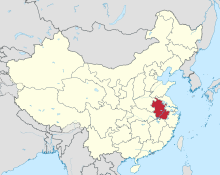Anhui musk deer
| Anhui musk deer | ||||||||||||
|---|---|---|---|---|---|---|---|---|---|---|---|---|
| Systematics | ||||||||||||
|
||||||||||||
| Scientific name | ||||||||||||
| Musk anhuiensis | ||||||||||||
| Wang , Hu & Yan , 1982 |
The Anhui musk deer ( Moschus anhuiensis ) is a type of musk deer (Moschidae). At times it was considered a subspecies of other musk deer species and is almost exclusively restricted to the southwest of the Chinese province of Anhui and possibly to neighboring areas of Hubei . It is considered critically endangered.
features
The Anhui musk deer is a fairly small species of musk deer. It reaches a head body length of 70 to 76.5 cm. The shoulder height is less than 50 cm, the tail is about 2–4 cm long. The body weight fluctuates between 7.1 and 9.7 kg. The basic color of the fur is gray-brown. There is a pattern of numerous light, washed-out spots on it. A light neck stripe is also noticeable. The ears are colored darker than the body. The hair is long and about 5.4 cm long on the trunk.
Distribution area and way of life
The distribution of the species seems to be limited to the southwest of the Chinese province of Anhui in the area of Dabie Shan , where it inhabits forested mountain regions. It may also be found in adjacent parts of Hubei . Little is known about eating habits or lifestyle. Apparently the females are fertile early and reproduce in the first year of life. In addition, twin births appear to be quite common. Otherwise, the social behavior and reproductive biology of other musk deer, in particular the Chinese musk deer , are likely to be similar. It is assumed, for example, that the animals are predominantly nocturnal.
Danger
The shape was originally considered a subspecies of the Siberian musk deer ( Moschus moschiferus ), later the Chinese musk deer ( Moschus berezovskii ) before it received species status. It is used by the IUCN as endangered ( Endangered ) classified. Like all musk deer, the Anhui musk deer is also hunted for musk , a substance that the males produce in special glands. Above all, the limited range makes the species vulnerable. In the 1980s, the total population was estimated at only around 700–800 animals and is likely to continue to decline.
Individual evidence
- ↑ a b c d C. P. Groves (2011). Family Moschidae (Musk-Deer). (P. 347). In: Wilson, DE, Mittermeier, RA, (Eds.). Handbook of the Mammals of the World. Volume 2: Hooved Mammals. Lynx Edicions, 2009. ISBN 978-84-96553-77-4
- ↑ a b musk anhuiensis in the endangered Red List species the IUCN 2012. Posted by: Wang, Y. & Harris, RB, 2008. Accessed November 1, 2012th
